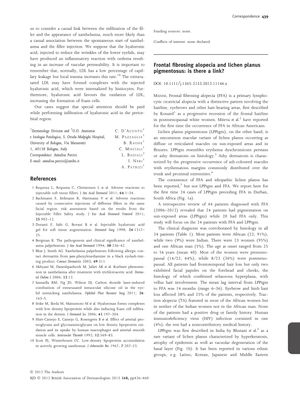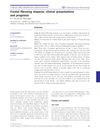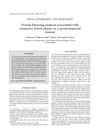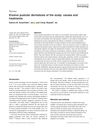Frontal Fibrosing Alopecia and Lichen Planus Pigmentosus: Is There a Link?
October 2012
in “
British journal of dermatology/British journal of dermatology, Supplement
”

TLDR There may be a connection between Frontal Fibrosing Alopecia and Lichen Planus Pigmentosus, and more research is needed to confirm this.
The document presents findings from a retrospective review of 44 patients with Frontal Fibrosing Alopecia (FFA), revealing that 24 of these patients also had Lichen Planus Pigmentosus (LPPigm). The study, which included predominantly African (91%) and female (95%) patients aged 25 to 56 years, suggests a potential link between FFA and LPPigm, with LPPigm often preceding FFA by approximately 14 months. This coexistence had not been previously reported, and the authors propose that LPPigm could serve as an early indicator of FFA, recommending that African patients with LPPigm be screened for FFA. The study concludes that LPPigm and FFA may be part of the same disease spectrum and calls for further research to confirm this relationship.
Additionally, the document reviews 58 studies on rosacea treatments, highlighting a lack of focus on patient-reported outcomes (PROs) and health-related quality of life (HRQOL). Only two studies assessed HRQOL, and the majority used substandard PRO assessment tools. Topical metronidazole and azelaic acid were reported to improve papulopustular rosacea, while topical ciclosporin improved quality of life in ocular rosacea. Laser and light therapies showed promise in reducing facial erythema and telangiectasia, important for patient self-esteem. However, the evidence quality was low to moderate, and further research on laser- and light-based therapies was recommended.
View this study on academic.oup.com →
Discuss this study in the Community →
Cited in this study
2 / results
research Frontal Fibrosing Alopecia: Clinical Presentations and Prognosis
FFA is more common in postmenopausal women, can affect younger women, and may stabilize over time.

research Frontal fibrosing alopecia associated with cutaneous lichen planus in a premenopausal woman
A premenopausal woman had hair loss and skin issues, treated with topical steroids.
Related
1 / results
research Erosive Pustular Dermatosis of the Scalp: Causes and Treatments
A rare scalp condition mainly in older women can be treated with various alternatives to steroids, which may have fewer side effects.